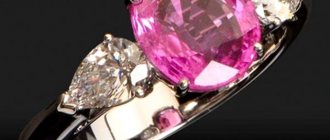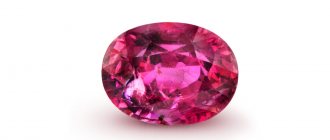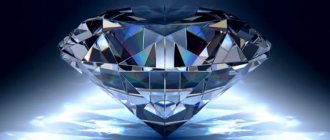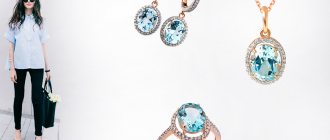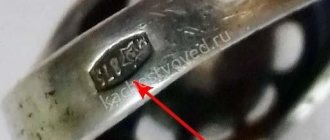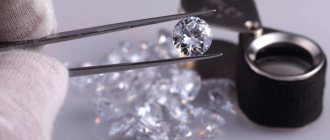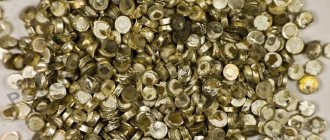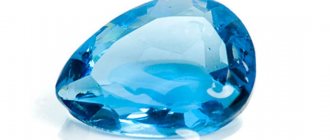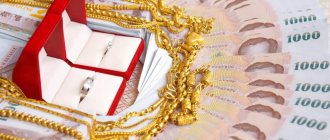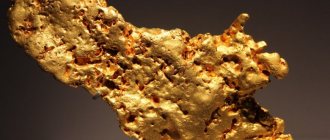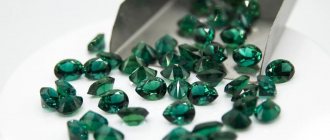Hello, friends! Buying a gemstone is a responsible matter. A natural gem is not just prestigious and beautiful. This is a profitable investment and the acquisition of a reliable ally for life. In order not to fall into the web of scammers and not to buy an imitation ruby instead of a ruby, you need to know how to distinguish a real ruby from an artificial one.
You can check the naturalness of the stone right in the store, or at home. There are several proven methods for this. Interesting? Read on.
Ruby is the oldest stone
Ruby was the most popular stone in ancient India, where it was considered the king of gems. The Greeks and Romans also valued ruby, believing that this stone promoted victories and great deeds, so the palaces of rulers and their clothes were often decorated with ruby items.
In the countries of the East, the stone personified vital energy, and its owners were given love, strength and health. In Russia, this gem became popular in the 9th century and was called yakhont (like its “brother” sapphire). This stone was considered the best gem, capable of giving strength and a healing effect on the heart, and since “yakhontovy” was previously synonymous with the word “precious,” the expression “you are mine, yakhontovy” was introduced as an appeal to the dearest beloved.
Magical meaning
Sapphires and rubies have been used in occult rituals since ancient times, so it has always been endowed with magical properties. According to esotericists, corundum is capable of exerting a powerful influence on the course of thoughts and actions of its owner. This is a stone of active and purposeful individuals, people with ambitions and high expectations.
Corundum will help you concentrate on the path to your goal. The stone actively supports the owner, driving away fears and increasing self-confidence. However, at the same time, it requires energy and active action from the owner. The gem is not suitable for lazy and mediocre people.
Blue sapphire is often given to people whose work involves mental activity. It is a stone of scientists and researchers. A real natural ruby can protect against negative energy and support in times of crisis. Earrings with this stone will help you find harmony, both with yourself and with the world around you, and a ring will allow you to reveal your hidden potential.
Mining rubies - when will nature run out of stones?
Mining such stones is not an easy task; rubies are found in rock layers at considerable depth, and ruby deposits are gradually decreasing. Scientists have calculated. That in a thousand years a person will extract the last natural stone from the depths.
The highest quality and most expensive rubies are mined in Myanmar (formerly Burma); stones from this deposit are also called “pigeon blood” because, in addition to their blood-red color, they have a purple tint. Pigeon blood is also found in Vietnam.
The city of Mong Shu in India also boasts exceptional rubies, most of which are black with red edges. They are often even more expensive than pigeon blood because they are extremely rare. Almost the entire population of the city is engaged in crystal mining.
Each deposit produces its own stone, which varies in shade; the third largest deposit is in Ceylon, where rubies of a unique coral color are mined. Although they are not as sought after as blood red, their price is also high.
However, recent studies have shown that even in these layers very few crystals remain. The last stone will be mined soon, which may indicate a further increase in the price of this unique mineral.
Price
The price of a stone depends on a number of its parameters, such as:
- purity;
- weight;
- shade;
- cut.
Category I rubies can cost up to $1,500 per carat. But the cost of the same stones, but category III, will be significantly different and will not exceed $400-500 per unit of weight.
The most expensive rubies are those from Burma. They are sold exclusively at auctions, where the price per carat starts at $3,000.
Sapphires are cheaper, somewhere around $150 per carat. However, the larger the stone, the higher the price per unit weight. Minerals larger than 8-9 carats cost at least 10 thousand dollars on the market.
Characteristics of natural rubies
Natural ruby is quite rare among other minerals, so an experienced jeweler can absolutely accurately distinguish a fake by the following characteristics.
The hardness of the crystal, ruby is second only to diamond in hardness, which makes it a class 1 stone - 9 points on the Mohs scale. With such a high hardness, the stone is very difficult to break and leave a scratch.
Due to its hardness, it can be easily processed by jewelers, and an experienced craftsman should be able to make clear edges from it.
Pink, coral and reddish-burgundy rubies are found in nature. Stones with black inclusions are also not uncommon.
The shine of rubies comes from the igneous origin of the mineral; natural stones shine very strongly in all shades of red.
Who is it suitable for?
Corundum is not suitable for everyone. When choosing jewelry with any type of this mineral, you need to take into account both external data and zodiac affiliation.
By zodiac sign and date of birth
The influence of corundum on its owner is closely related to his zodiac sign.
| Zodiac sign | Type of corundum (color) | Influence |
| Aries | Sapphire blue and yellow | Aries should wear corundum only after 40 years. In this case, they will work as amulets, providing, among other things, a rejuvenating effect |
| Taurus | Blue and cyan sapphire | A Taurus talisman with a stone will protect you from illness, allow you to develop intuition and realize hidden talents. The mineral has a good effect on memory |
| Twins | Dark blue, purple sapphire | Geminis wearing the stone will have improved leadership qualities. Sapphire will not allow the owner to quit halfway |
| Cancer | Any shade of sapphire and ruby | The stone as a talisman will reveal your potential and bestow extraordinary luck. Corundums make Cancers more positive and open |
| a lion | Contraindicated | Wearing a stone can lead to aggravation of relationships with loved ones, conflicts with loved ones |
| Virgo | Green and blue sapphire | Corundum will give a skeptical Virgo positivity and encourage dramatic changes in life. |
| Scales | Purple sapphire, red ruby | The combination of Libra and corundum is the key to success. Representatives of this sign, equipped with a talisman, will experience success in any endeavor |
| Scorpion | Red and pink ruby | For closed Scorpios, the gem will help them make friends and improve relationships. Red ruby ignites passion |
| Sagittarius | Black blue sapphire | The stone teaches sharp Sagittarius delicacy and diplomacy, brings idyll and peace to the house |
| Capricorn | Contraindicated | The gem enhances phobias and negative character traits |
| Aquarius | Transparent corundums | The stone will help this sign find its life path and attract good luck. |
| Fish | White corundums | For altruistic Pisces, the mineral will help replenish energy reserves and ward off melancholy |
If we talk about dates of birth and their connection with the zodiac, then corundum is a talisman for those born on the following days:
- Aries – March 22, 28;
- Taurus – April 26;
- Gemini – May 21, 27;
- Cancer – June 21;
- Leo – July 25, 25;
- Virgo – September 6, 17;
- Libra – October 19;
- Scorpio – October 25, November 8;
- Sagittarius – December 14, November 29;
- Capricorn – January 2, 8;
- Aquarius – January 29, February 6, 17;
- Pisces – February 21, March 7.
Knowing the talisman stones by date of birth, you can choose a successful and useful gift.
By color type
Color type is a person’s natural palette, characterized by the color of hair, skin and eyes. There are 4 main types of appearance in nature, which are correlated with the seasons.
| Color type | Characteristic | Stone |
| Summer | Blonde hair, translucent pink skin, gray, green and blue eyes | Blue sapphire |
| Autumn | Dark brown, brown and red hair, slightly dark skin, brown and green eyes | Chlorosapphires, red rubies |
| Winter | Dark hair, white “porcelain” skin, blue, green and gray eyes | Ceylon dark red rubies, black and blue sapphires |
| Spring | Light blond, wheat-colored hair, brown and green eyes. Peach skin tone | Yellow, pink sapphires, padparadscha rubies |
The table presented will help you choose the most successful option for decorating with a stone.
Ruby stone - properties
Nature has created dozens of red minerals. To find a precious ruby among other red stones, you need to know its properties.
Ruby is a type of corundum, an aluminum oxide that is very hard and very durable. Rubies can be identified by their deep red color, which leans towards purple, dark pink and may have black undertones or reflections.
In addition to color, these stones are distinguished from glass and other minerals by their intense shine, similar to that of a diamond.
How to determine whether a ruby is natural or not
Distinguishing a real ruby from a similar colored mineral such as garnet, tourmaline or precious spinel is truly difficult. Reliable methods for determining the authenticity of a ruby only emerged in the mid-19th century with the development of mineralogy, after which it was discovered that many famous scarlet gems, including those in crowned heads, were not rubies, but tourmalines or spinels, which were mined in Indochina.
Determining its syngony, lattice group, isotropic and anisotropic properties is the key to determining its authenticity. Ruby has light anisotropy (in the optical region) and these properties cannot be tested at home, but properties such as low heat capacity (slow heating) can.
How to obtain synthetic ruby
The first synthetic ruby was obtained by the French scientist Auguste Verneuil. This gave a great impetus to the production of the gemstone in large quantities for almost all countries. In addition, thanks to the scientist, other minerals began to be cultivated; The technology by which the first artificial crystal was obtained is the so-called Verneuil method. It consists of the following steps.
- The mixture of oxides is placed in a special hydrogen-oxygen burner (Verneuil furnace).
- Substances melt.
- When cooled, the droplets form a crystal.
The gemstone grows first in the shape of an expanding cone and then a cylinder, which is surprising, but with this method you can get a ruby in just a few hours. Currently, there are many different methods for obtaining synthetic ruby.
Methods for synthesizing artificial crystals
In the mid-twentieth century, rubies grown synthetically began to appear on the jewelry market. Synthetic stones are visually almost no different from their analogues. Obtained by growing a single crystal from corundum.
Modern technologies make it possible to “grow” rubies with properties close to the original. Synthetic stones have ideal transparency, large size and almost complete absence of cracks. But an experienced jeweler can easily distinguish a stone of natural origin from a synthetic one.
Today, artificial rubies are produced using four methods:
- Czochralski;
- Vernel;
- flux;
- hydrothermal.
The most advanced methods are Czochralski and Vernel. By the way, the French scientist Vernel was the first who managed to grow synthetic ruby. Using these methods you can obtain the largest and cheapest stones. Minerals grown using these methods are distinguished by their curved growth lines.
Flux and hydrothermal methods are very expensive, but with their help it is possible to grow the most perfect rubies. Often, even experienced jewelers can hardly tell by eye what is a natural stone and what is synthetic. Therefore, when purchasing a large specimen, just in case, it is better to consult an experienced gemologist.
Red stone - who besides ruby
In the jewelry industry, minerals such as precious spinel, red and pink tourmaline and garnet are used as substitutes for the rare gemstone red corundum ruby.
How to distinguish a ruby from a garnet
The easiest way to distinguish a natural garnet from a natural ruby is to look at its shine, which is much weaker in garnet.
Garnet is a different shade of red stone, with a tendency away from purple; the color is more consistent with old red wine.
Garnet is softer, up to 7.5 on the Mohs scale, has a different crystal lattice shape and has a resinous rather than glassy luster. In sunlight it has a dull shine, while red corundum shines brightly.
Garnet can be recognized by its magnetic property, which ruby does not have.
Differences between ruby and tourmaline and spinel
Tourmaline also bears a close resemblance to ruby, especially the inexpensive, bright red and pink ones. It has a rich pink color and the same glassy shine; When examining gemstones, tourmalines are sifted out by shining them under an ultraviolet lamp.
Ultraviolet light passing through tourmaline or other scarlet crystal produces an orange glow; passing through a ruby, it remains red. In the same way, you can distinguish a real ruby from a synthetic one.
The most difficult thing to distinguish a fake is when it comes to precious red spinel. It is impossible to do this yourself, since spinel has similar properties, but the difference with ruby is very small. To check the authenticity of a stone suspected of being spinel, you need to contact a jewelry laboratory. Spinel crystals have a strawberry hue, like some types of rubies.
If you have any doubts about the originality of a stone, especially if it is set with precious metals, it is best to consult a jeweler or local appraiser's office.
Price and features
Ruby is the second most important gemstone after diamond. It also has high density and strength. Its edges shimmer in the light with a glow. True, not white, like diamonds, but red. It seems that you can watch these overflows forever. The cost of rubies is close, and in some samples even equal to the cost of diamonds.
Therefore, when going to a jewelry salon, you should be well prepared for your purchase. Because ruby is not very common in nature, and modern industry is not asleep. People have learned to produce artificial rubies. In addition, the thirst for profit pushes some sellers to offer other minerals, or even glass, under the guise of ruby.
Natural ruby faceted
To figure out what is offered to you in the salon, you should arm yourself with a tenfold magnifying glass and an ultraviolet flashlight. You can also bring a glass jar or glass from home.
Types of rubies
If you are looking for an answer to the question of how to distinguish a ruby, it is worth considering what types of stones nature has created. There are not many varieties.
Burmese. Named after the place of extraction, samples are found in Myanmar. The red color is very bright and saturated, the stone is quite expensive, so you can distinguish a ruby from a fake just by the price. High prices are set only for certified goods.
Ring with Burmese ruby and diamonds
Pigeon blood. Distinguished by the appearance of a purple glow, ruby is very valuable, its price is similar to diamonds, it is difficult to counterfeit the stone, you will have to combine several ingredients with metallic impurities, trying to preserve the special properties. These actions are practically impossible.
ruby pigeon blood
Star-shaped, the rarest type of crystal that can be found, the inner glow is similar in shape to a star, it is unlikely that even the most skilled craftsman will be able to reproduce such a miracle of nature.
Types of samples
To avoid buying a fake, it is important to know what rubies are found in nature. There are not so many of them, the main and most common are:
- Burmese ruby. Everything mined in Myama has a certificate. The price for them is always very high. The crystals are deep red in color and very bright.
- Pigeon blood. Stones mined in Myanmar must also have a certificate. They are distinguished by a very dark color, often giving off a purple tint. It is almost impossible to counterfeit “pigeon blood” due to some technical aspects of the process.
- Star crystals. They are the rarest and most expensive. The name speaks for itself. Inside the crystal, the glow has a star shape. And just like “pigeon blood”, it is impossible to fake starlight today.
How is ruby different from corundum?
For the uninitiated, corundum and ruby are the same minerals, since both stones are bright red in color with a characteristic shine, are resistant to mechanical and chemical influences, are very hard and do not have adhesion. How are they different? To understand, it is important to know what exactly corundum is, since we are already dealing with ruby.
Corundum is a hard and durable mineral, second only to diamond. In the natural environment, it occurs both in the form of single crystals and in the form of crystals arranged in columns. Primary colors of corundum:
- black;
- red;
- green;
- pink;
- white.
This wide range of colors is one of the main differences between this gemstone and ruby, which only comes in shades of red and burgundy.
Sapphire, amethyst and leucosapphire are also varieties of gemstones, and it is believed that rubies are sapphires that are not fully mature. After the collapse of Pangea (a single ancient continent), a large deposit of stones was destroyed, as a result of which some of the rubies remained in the ground, and some were under water. The first was saturated with metallic impurities and acquired a characteristic red color, while the second received blue, yellow and other shades.
Artificial rubies, how to distinguish them from natural stones?
In order to accurately distinguish a real ruby from a fake or artificially grown stone, it is important to know a few simple rules on how to identify a ruby at home.
- In bright light, natural stone takes on a darker shade.
- An imitation of the original gemstone will have an orange tint when exposed to ultraviolet light.
- Like most natural gemstones, ruby has a low thermal conductivity and when placed against your cheek, it will remain cool for a long time.
- Artificial corundum has the most perfect shape, precise and even edges, which is completely uncharacteristic of a real mineral.
Corundum
- The presence of bubbles and inclusions is an important detail by which you can determine whether the product is real or not. Red blotches are a sign of naturalness, and white bubbles are a sure sign of a fake.
- A synthetic gemstone is grown using the fluxing method, as a result of which partial inclusions of flux can be seen in it.
- The brilliance of a decorative crystal is dull and subdued, while the brilliance of the original stone resembles that of a diamond.
How to identify ruby at home
Before purchasing exquisite red crystal jewelry, it is important to check its authenticity. You can find out about the origin of a ruby at home or with the help of a special expert. The most important thing is to use effective methods to test natural stone.
- Place the precious mineral into an empty glass container; If you have a natural ruby in front of you, a pale red glow will appear in the dish.
- If you dip a real stone into a vat of cow's milk, the liquid takes on a characteristic pink hue.
- If you examine a real mineral in your hands, on one side of the stone the color will be dark burgundy and rich, and on the other it will be bright red and faded.
- Mechanical damage on artificial stone is a visually noticeable, straight and shiny stripe. A crack in a natural ruby has a zigzag shape and a matte color.
- If there are air bubbles in the structure of a precious mineral, they will definitely be red and round. In imitation ruby, the bubbles are “hollow”, hollow and white.
- The density of a natural stone is much higher than that of an artificially grown mineral, so the weight of the same ruby and its fake is different.
To produce cheap imitations, jewelers use glass or plastic, which when cut look like natural rubies. To be sure of the authenticity of the gemstone, it is better to check the crystal using all of the above methods. Only an integrated approach to identifying natural ruby guarantees the quality of the mineral.
If you liked the article, share it on social networks. This is important to us, thank you
Tags: How to identify ruby at home, properties and features of the gemstone
Application
In addition to the jewelry industry, corundum derivatives are actively used in a variety of industries. In optics and instrumentation, sapphire glass is used to increase the strength of lenses. In the aircraft industry, windows are equipped with this part.
In mechanical engineering and machine tools, corundum with a high iron content is used as an abrasive material. Artificial sapphires are needed for the production of medical instruments, luxury watches, mobile gadgets and digital equipment.
In construction, corundum is used as a component of the thermal insulation layer.
